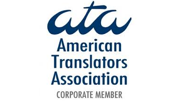July 25, 2014 by admin
Get a Free Quote
Our Accreditations





Recent Updates
Buckets and spoons: an etymological tour of death metaphors
The need to translate English into English is more common than you might imagine, where phrases of English are deployed in a foreign language and have taken on an alternative meaning that isn’t appropriate in actual English text. Read More
Whether you need help with interpreting to facilitate conversation between a group, during a conference or similar event, or on a one-to-one basis, at Rosetta Translation Ltd, we can provide services to assist you.
However, there are a number of different modes of interpreting that we offer, each suited to a range of scenarios.
So, what are they and when are they most suitable?
Meetings
Consecutive interpreting is mainly used among medium and small-sized groups, where the interpreter and speakers take it in turns to talk.
To facilitate this, the interpreter may sometimes make notes if the sections of speech are particularly long to ensure that what they are interpreting is accurate.
It is also known for this form to be used in a setting that involves larger gatherings, at which point speakers and a microphone may also be required.
Another related form of this service is liaison interpreting, which is often used in a one-on-one setting, such as chaperoning or a meeting between two business associates.
In court
If a person involved in court proceedings does not speak the local language, then a court interpreter is essential.
The professional enables their client to follow what is going on in this legal setting, meaning there is no room for inaccuracies as even a small mistake could be devastating to the case.
Sometimes, this mode of work can be a challenge if the court system doesn’t allow for interpreting equipment to be used in the courtroom and interpreters can occasionally ask the judge for a break if they feel it is necessary for them to effectively do their job.
Large conferences
An example of simultaneous interpretation in action is when delegates of the United Nations meet. With so many different languages being spoken, officials will often wear headphones, where they will be able to hear the speech being interpreted into their own tongue.
This mode is generally ‘faceless’ compared to other methods, as the interpreter is a behind-the-scenes presence.
Because this type is continuous, as opposed to consecutive interpretation where the speaker and interpreter effectively take turns, a high level of concentration is required by the professionals carrying out this service and they often work in pairs in blocks lasting 20 minutes or so, in order to allow each other a rest.
Long distance meetings
One of the main advantages of telephone interpreting is that the interpreter can do their job from anywhere in the world, which means it is a much more flexible service. Another bonus is that you or the person you want to speak to don’t have to be in the same location, reducing travel costs.
All participants (the speakers and the interpreter) communicate over a phone line, in what is another form of consecutive interpreting.
It is generally used in a conference call or three-way setting, with the interpreter again doing their job in between the other participant’s chunks of speech.
Presentations and small groups
Whispered interpreting – also known as ‘chuchotage’ – is generally used in bilateral meetings or when only a few people within the group don’t share the same language.
This form involves the interpreter whispering what is being said into their client’s ear and can be used to save time during a meeting or presentation, when the nature of consecutive interpretation may disrupt the flow somewhat.
Sign language interpreting
Members of the deaf community in the UK who speak British Sign Language (BSL) can use this form of interpretation to communicate with those who are unable to sign – after all, this too is another language!
However, while this service operates in the same way as any other interpreting assignment, there are options for those who are deaf but do not understand BSL. Lip speaking is one example, where an interpreter will repeat dialogue using lip patterns that are easy to read.
Another variant is Signed Supported English, which utilises signs that follow the English sentencing structure more closely than BSL and offer more direct, word-for-word interpretations. Typically, this is best suited to those who are deaf but have a quality grounding in the English language.
Written by Chan Sumray
Get a Free Quote
© 2024 All Rights Reserved
Rosetta Translation, 133 Whitechapel High St, London E1 7QA · 0207 248 2905
Comments
Add Comment